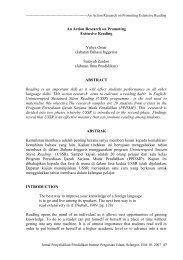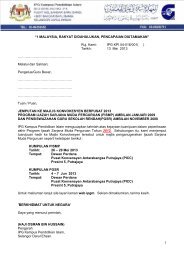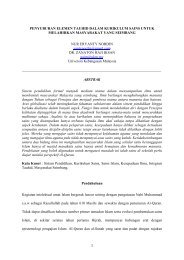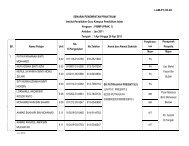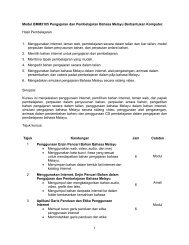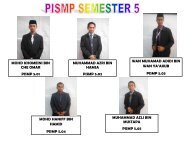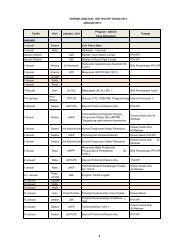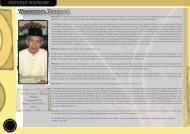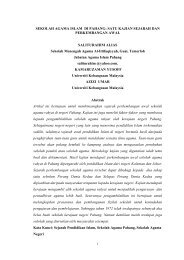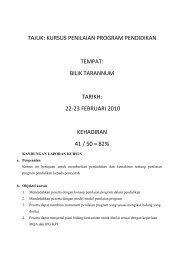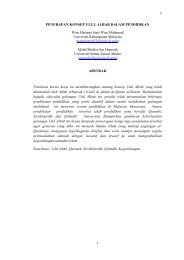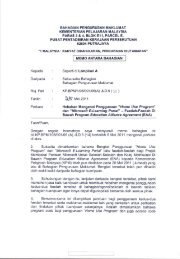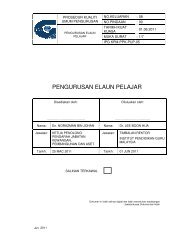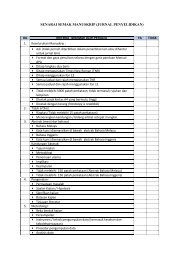61 KESAHAN DAN KEBOLEHPERCAYAAN DALAM KAJIAN ...
61 KESAHAN DAN KEBOLEHPERCAYAAN DALAM KAJIAN ...
61 KESAHAN DAN KEBOLEHPERCAYAAN DALAM KAJIAN ...
Create successful ePaper yourself
Turn your PDF publications into a flip-book with our unique Google optimized e-Paper software.
72<br />
Pentafsiran pekali kebolehpercayaan yang boleh diterima mengikut pengamal<br />
penyelidikan dalam sains sosial ialah lebih daripada α = .60. Dengan menggugurkan<br />
butiran-butiran yang merendahkan pekali tersebut (dalam construct dan indicator item),<br />
penyelidik boleh meningkatkan nilai reliabiliti terhadap alat ukur. Mengikut Mohd. Majid<br />
Konting (1993) tahap α = 0.71 – 0.99 adalah tahap yang terbaik (71% - 99%<br />
kebolehpercayaan item oleh sampel) 29 . Fraenkel dan Wallen (1996) meletakkan nilai<br />
reliability item yang diterima pada tahap α = 0.70 – 0.99 30 . Kubiszyn dan Borich (2000)<br />
menentukan nilai α = .80 - .90 reliability coefficients yang diterima 31 .<br />
Manakala Popham (1990) pula ialah pada tahap α = .90 - .95 32 . Tafsiran nilai cronbach alpha<br />
( α ) correlation coefficients adalah seperti berikut:<br />
0.00 hingga + 1.00 = pada asasnya 33<br />
.60 hingga .70 = satisfied coefficients<br />
.70 hingga .80 = stability coefficients<br />
.80 hingga .90 = customary coefficients<br />
.90 hingga .95 = sufficient coefficients 34<br />
.80 hingga .90 = acceptable reliability<br />
.90 hingga + 1.00 = very good reliability 35<br />
.95 hingga + 1.00 = acceptable standardised test<br />
for internal consistency 36 .<br />
29<br />
Mohd. Majid Konting (1993), op.cit., h. 182.<br />
30<br />
Fraenkel J.R dan Norman E. Wallen (1996), op.cit., h. 163.<br />
31<br />
Tom Kubiszyn & Gary Borich (2000), Educational Testing and Measurement : Classroom Application and<br />
Practice. Sixth Edition. New York : John Wiley & Sons, Inc., h. 319.<br />
32 James Popham (1990), Modern Educational Measurement. A Practitioner’s Perspective. 2 nd Edition, New<br />
Jersey: Prentice Hall, Englewood Cliffs, h. 127.<br />
33 Howard B. Lyman (1986), Test Scores and What They Mean. Fourth Edition, New Jersey : Prentice Hall<br />
Englewood Cliffs, h. 29. Juga boleh dilihat dalam, William Wiersma (2000), Research in Education : An<br />
Introduction. Boston : Allyn and Bacon, h. 297.<br />
Reliability coefficients can take one values from -0.1 to +1.0 inclusive conceptually, if a reliability coefficient<br />
were 0, there would be no ‘true’ component in the observed score. The observe score would consist entirely of<br />
error. On the other hand, if the reliability coefficient were 1.0 the observed sore would contain no error. 1.0<br />
consist entirely of the true score, although coefficients of 1.0 are very rare inded<br />
34 Walter R Borg & Meredith Damien Gall (1979), Educational Research : An Introduction. 3 rd Edition, New<br />
York, London : Longman, h. 97.<br />
35 Vierra, A. & Pollock, J. (1992), Reading Education Research. Scottsdale : Gorsuch Sewishirch, h. 86.<br />
36 Tom Kubiszyn & Gary Borich (1993), Educational Testing and Measurement. New York : Harper Collins, h.<br />
166.



